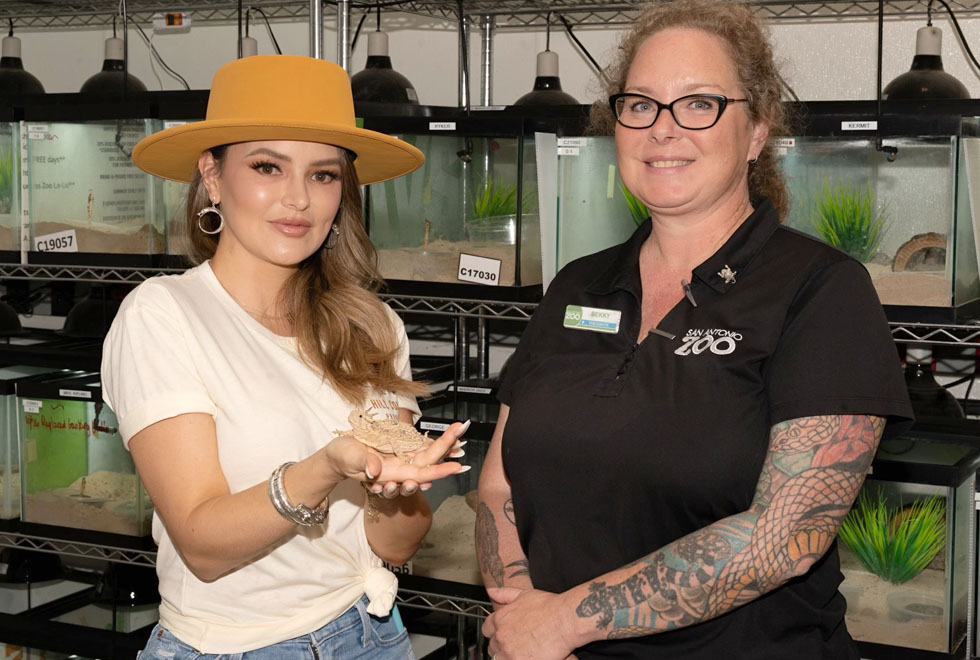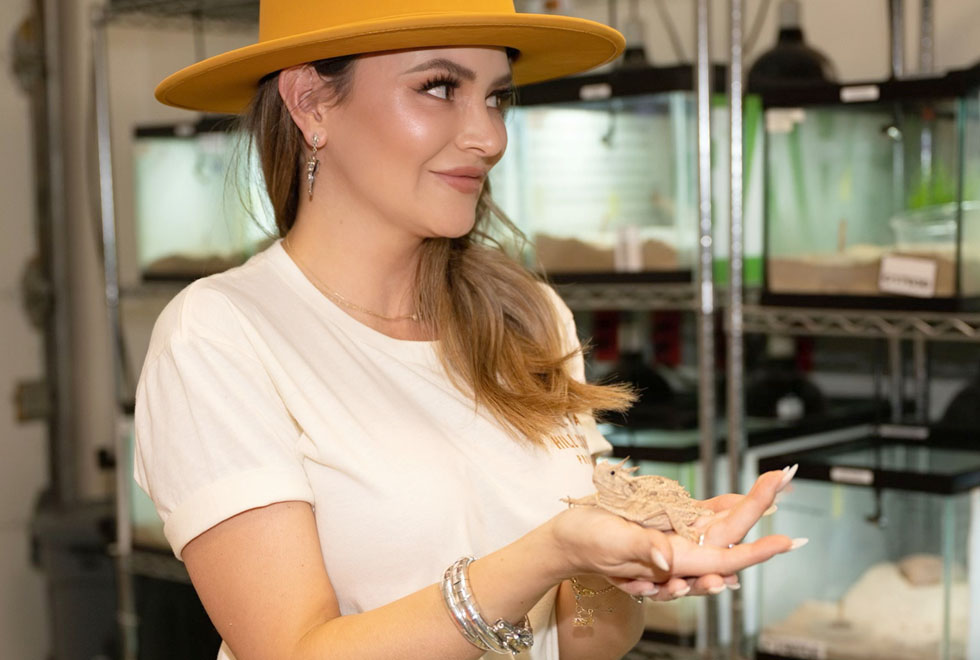
One of my favorite aspects of environmentalism is restoration. Whether it’s replanting trees or animal conservation, my passion is working to restore the natural order of our planet and protect it for generations to come.
The Texas Horned Lizard Reintroduction Project at the San Antonio Zoo is a wonderful effort to reintroduce an iconic Texas inhabitant to our lands! I was excited to go behind the scenes of this monumental project to learn more. I’d like to share some of the highlights with you.
One thing I appreciate about these species protection and reintroduction projects is that we always learn more about how to help all species while we are protecting one.
The Texas Horned Lizard: A Keystone Species
Also called the “horny toad,” the Texas Horned Lizard is a fierce-looking lizard with many little horns or spikes on its head. It’s usually brownish in color, with two rows of fringed scales along the side of its body.
Horny Toads live in arid and semiarid habitats in the south-central US. Their primary habitats are throughout Texas, Oklahoma, Kansas, and New Mexico.
Texas horned lizards look for land with very little plant cover. They dig for nesting, hibernating, and insulation purposes, so they like to live in areas with loose sand or soils.
One strange skill of the horny toad is the ability to squirt blood from their eyes! When they are threatened, a horned lizard will force the blood pressure in their sinus to increase, bursting a blood vessel and squirting blood from its eye. Scientists have observed lizards squirting blood as far as a meter to defend themselves from predators.
What is a keystone species?
The Texas horned lizard is a keystone species. These are species that help define an entire ecosystem. Many plants and animals depend on that species, so without it, the ecosystem would change dramatically.
Horny toads mainly eat harvester ants. A single Texas horned toad can eat over 100 ants per day, helping keep this destructive insect in check.
The horned lizard is also a critical food source for a variety of snake and bird species. Without a healthy horned toad population, the harvester ants go unchecked, and the snake and bird populations struggle.
What is threatening the Texas Horned Lizard?
The Texas horned lizard is currently a threatened species. Scientists have documented a significant decline in horny toad populations throughout the Midwest and Southwest.
Though it looks like a modern-day dinosaur with its spikes and scales, it is a surprisingly delicate critter. It is illegal to kill horny toads or collect them for pets in Texas, but the illegal pet trade is thriving. Though the lizard doesn’t do well in captivity, some people try to capture and keep them as pets because of their unique appearance.
Another threat the Texas horned lizard is facing is invasive red fire ants. The fire ants out-compete the native harvester ants that make up a huge portion of the horny toad’s diet. Without the harvester ants, horny toads starve.
Pesticides and drought from climate change are also impacting the horny toad’s natural environment, not to mention the loss of habitat to expanding cities.
The Texas Horned Lizard Reintroduction Project
The Texas Horned Lizard Reintroduction Project at the Center for Conservation and Research (CCR) is committed to restoring the Texas Horned Lizard population. Their goal is to partner with private landowners to reintroduce horny toads into areas where conservationists have documented a dramatic decline in horny toad populations.
The reintroduction project partners with the San Antonio Zoo to hatch the Texas horned lizards in captivity and then release them into the wild.
The zoo has a large “Lizard Lab” with habitats for adult horned lizards who breed. There is also a “nursery” habitat for hatchling lizards as they grow.
While the zoo staff is busy hatching horny toads, the CCR team assesses potential release sites. They visit the lands of owners who are interested in participating in the project to find ideal habitats.
Releasing and tracking Texas horned lizards
Juvenile Texas horned lizards are released on private lands in early fall. The horned lizards must be large enough to eat regular-sized harvester ants before they can be released into the wild.
Before they are released, the team takes photos of the bellies of each lizard to document their unique markings. Each lizard is assigned a number for monitoring purposes, and they document the precise GPS location of their release site.
The Texas Horned Lizard Reintroduction Project released 50 horned lizards in September 2022, but the work doesn’t stop there! After the lizards are released, the conservation team continues to monitor them. They have five teams of conservation sniffing dogs who work with Kieron Canine Training to learn to sniff out the scat, shed, and eggs of the lizards.
These valuable canine team members are called “Toad Sniffers,” and they help researchers track the lizards after their release to monitor the success of the program.
This video goes into more detail about the Texas Horned Lizard Reintroduction Project and all the people that play critical roles in its success.
Conservation efforts require collaboration and cooperation
The Texas Parks and Wildlife Department is another partner organization that is helping the project by creating a custom conservation license program to protect the Texas horned lizard.
Overall, this conservation effort is a perfect example of the work that the Association of Zoos and Aquariums (AZA) champions. AZA-accredited zoos all over the world participate in species survival plans and reintroduction projects for hundreds of endangered and threatened animals. Without their leadership, guidance, and expertise, the Texas Horned Lizard Reintroduction Project and many other valuable efforts would not be successful.
There are many organizations and individuals partnering in the Texas Horned Lizard Reintroduction Program. It’s a complex initiative with many moving parts. Truly, that is what conservation requires–the passion and effort of many people with many skills and resources to accomplish great things.
From the biologists researching populations of wild horny toads to the landowners willing to host the reintroduced lizards, everyone plays a critical role in the success of the Texas Horned Lizard Reintroduction Project.
What role can you play in conservation around you? I invite you to research what kinds of species conservation projects might be going on in your area. Are there ways you can help?
If you’d like to donate to the Texas Horned Lizard Reintroduction Project, here is the link.
